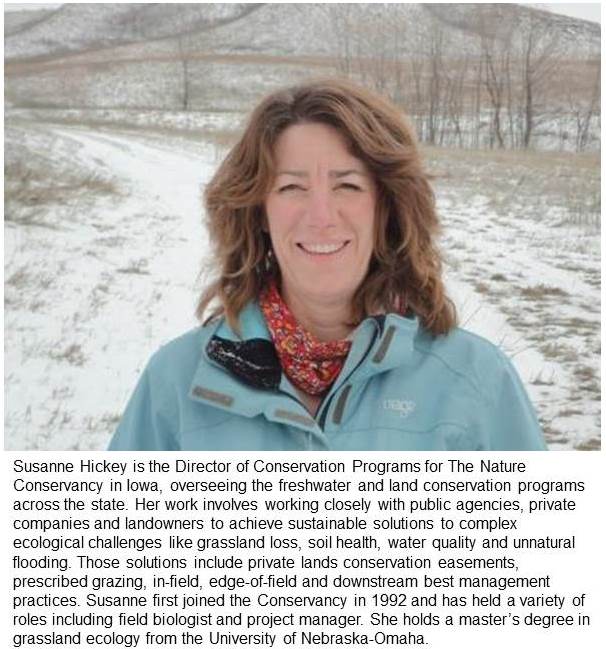How do we reach 90,000 Iowa Farmers? A Q&A with The Nature Conservancy's Susanne Hickey
By: Corporate Communications
June 7, 2016
Sustainability
Share
Earlier this year, CF Industries and The Nature Conservancy teamed up to advance sustainable agriculture practices with the 90,000 farmers in Iowa. CF spoke with Susanne Hickey, Director of Conservation Programs for The Nature Conservancy in Iowa, about the scope of the work, why Iowa is so important to this effort, and where the greatest opportunities are for success.
CF: Describe some of the work The Nature Conservancy has undertaken in the last 10 years regarding water quality in Iowa.
Susanne Hickey: For the past decade, our water quality work in Iowa has primarily centered on the Boone and Cedar watersheds. Since more than 80 percent of the land in the Boone watershed is used for row crop production, we’ve spent a great deal of time building relationships with the agriculture community, including individual farmers and agricultural groups. We’ve strived to promote a suite of sustainable agricultural practices—cover crops, conservation tillage, and the 4R’s of nutrient management—that are helping to safeguard our waters and floodplains while improving soil health and empowering growers to meet the rising demand for agricultural products.
In the lower reaches of the Cedar River, before it flows into the Mississippi, we’ve been working to restore floodplain habitat. Not only is this essential for wildlife habitat, but a healthy floodplain retains nutrients flowing off croplands, stopping them from moving downstream. About a year ago, we established a project director in Cedar Rapids to work in the upper parts of the Cedar watershed, working with partners to establish wetlands and oxbows and supporting a number of collaborative projects aimed at increasing agricultural conservation practices.
CF: Why is Iowa so central to your efforts to improve water quality?
Hickey: Water quality is an issue of utmost importance for our whole nation, including Iowa. From a state perspective, we need to have a clean, abundant water supply for our citizens to drink and to support our industry and wildlife. From a national perspective, if we can find solutions that work here in Iowa, we can apply that science to other places. Iowa, Indiana and Illinois are the top three states that contribute the most nutrient – mostly nitrogen and phosphorus – runoff to the Mississippi River Basin, which in turn causes the hypoxia zone each year in the Gulf of Mexico. If we can improve our water quality, we are not only creating a better environment for Iowans, but we’re helping all those who live downstream from us.
CF: What has been the most interesting thing you’ve learned in the 10 years the Conservancy has worked on water quality issues in Iowa?
Hickey: We’ve all heard the saying that “information is power,” but in this case, information has been essential as a change agent. The science behind our work has led to some insightful data, and when we put that data in the hands of agricultural producers, it has given them a new understanding of their role in the state’s water quality issues and helped them make informed decisions about how they manage their farmlands. Science – and sharing that science—is critical to improving our water quality issues.
CF: The Nature Conservancy has hired an agricultural program manager with the CF grant. How will this role help advance water quality work in Iowa?
Hickey: Yes, we’ve hired Greg Wandrey as our new Agriculture Program Director in Iowa. Until now, we’ve worked mostly at the watershed level in Iowa, but having Greg on board is enhancing our capacity to work with the many stakeholders across the state. With a background in agronomy, Greg is helping us bridge the proverbial gap between the agriculture world and the environmental world.
CF: A key purpose for the CF partnership with The Nature Conservancy is to advance the overall goal of the Iowa Nutrient Reduction Strategy, which aims for a 45 percent reduction of nitrogen and phosphorus runoff into the state’s waters. What are the greatest opportunities to achieving that goal?
Hickey: To achieve a 45 percent reduction in nutrient runoff, we need to work at an unprecedented scale. Every farm in Iowa will need to implement best management practices to keep nutrients on the lands and out of the rivers and stream. So, how do we reach 90,000 farmers? By bringing together stakeholders who are working together, moving in the same direction with the same goal. It’s a challenge, but it’s an opportunity to expand our successful small watershed projects statewide and beyond to make a dramatic impact throughout the Mississippi River system.
CF: What kind of stakeholders do you hope to bring together to help the program achieve success?
Hickey: The Nature Conservancy has a proven history of bringing diverse interests together to solve complex problems. Our conservation success hinges on our ability to bring together a range of private and public partners—from agriculture companies and associations to public agencies, environmental groups and urban interests—to collaborate on innovative solutions that benefit both the farming community and the environment.
CF: While you’re working with the agriculture community and communities to improve water quality in rivers and streams, individuals can make a difference as well. What are some steps each of us can take in our daily lives to support improved water quality?
Hickey: Everyone can make a difference and help to improve water quality in their communities and state. For instance, consider supporting local, state and federal funding initiatives for natural resources. If you own a home, landscaping with native plants and applying the principals of 4R fertilizer management— applying the right fertilizer in the right amount at the right rate and the right time—to your home garden are important. Most importantly, be informed. Know what watershed you live in and learn what happens to the water that falls on your property.
